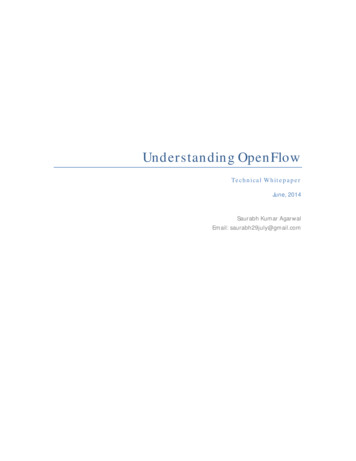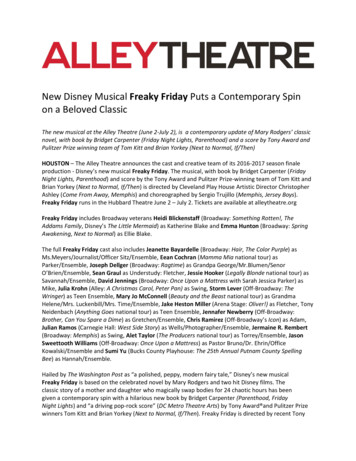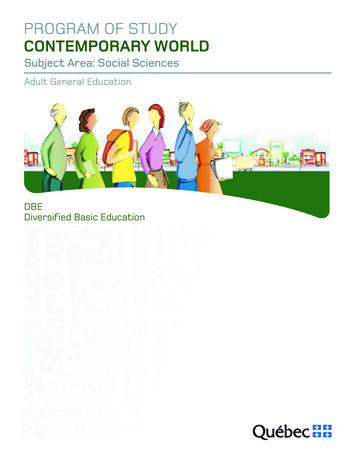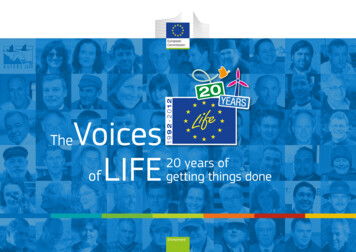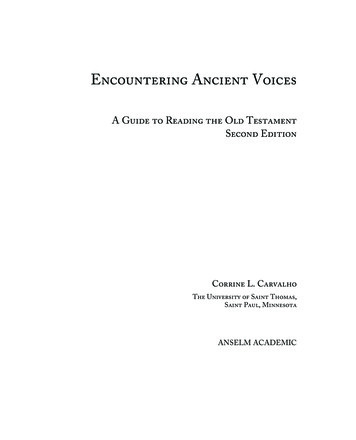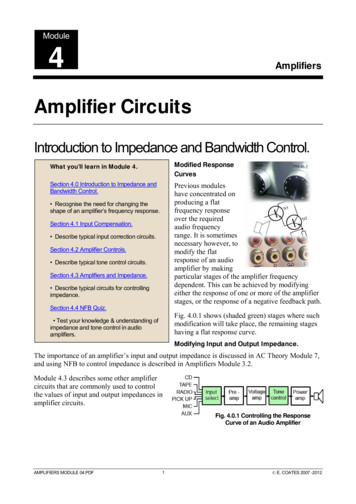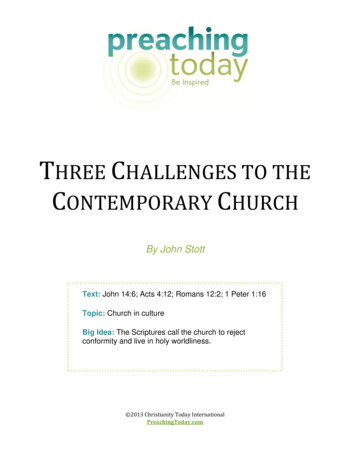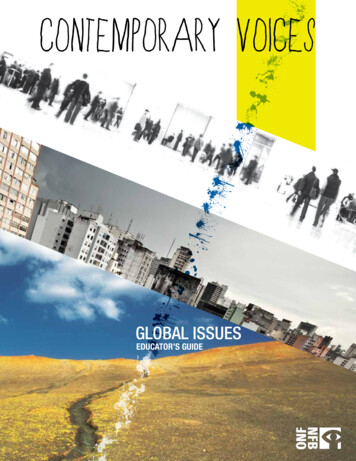
Transcription
CONTEMPORARY VOICEsGLOBAL ISSUESEDUCATOR’S GUIDE
Table of ContentsOverviewIntroductionNFB Global Issues PlaylistRecommended Age LevelAbout the GuideLearning ApproachesGeneral Learning Outcomes2222223Global Issues –seven broad categories4Glossary5The KWL(C) Chart6What is the KWL(C) Chart?The KWL(C) ChartDiscussion Questions Basic Information (The 5 Ws) Global Challenges General Questions Specific Questions Causes Consequences Ethical Dilemmas, Human Rights and Values Solutions Cultural Perspective Historical Perspective Taking Action678899911111111111111Media Literacy Questions12What is Media Literacy?Media Literacy in the Context of Films on Global IssuesDigital LearningMedia Literacy Questions1. Message2. Audience3. Production4. Impact1212121313131314Curriculum Matrix15List of Resources19References 23
introductionIn our rapidly changing world, as we face multiple challenges on aninternational scale, education for global citizenship is key. We needto address issues that impact us all, such as poverty in marginalizedpopulations; climate change; sustainability and social, economical andpolitical justice.Education for global citizenship encourages youth to develop empathy forothers living across the planet and to realize we all share our environment.When educators raise students’ awareness of the issues, deepeningtheir understanding and mobilizing them to take action, they are helpingstudents to become more conscious of our interconnectedness andinterdependence. By teaching global citizenship, we provide studentswith the skills to participate in ensuring their own and our collectivewell-being. Introducing international issues in the classroom empowersstudents and motivates them to contribute positively to a society thatvalues human rights, justice, global solidarity, environmentalsustainability, global health and peace. Documentaries are powerfultools for educating students about global issues and helping them tounderstand and change the world they live in on a local and global scale.CONTEMPORARY VOICES: FILMS FORGLOBAL EDUCATION PLAYLIST2The National Film Board (NFB)’s CONTEMPORARY VOICES: Films forGlobal Education Playlist and the Global Issues Film List were createdto help educators integrate documentary films about various global issuesinto secondary education, across several subject areas. It has beendeveloped to suit the curricula of provinces and territories throughoutCanada. The films were selected to represent a variety of global issues,which fall into seven broad categories (see Overview on page 3).Educators, to show NFB films or NFB Interactive projects that are online to yourstudents you require a subscription to CAMPUS. Your ministry of educationor school board may have already purchased a subscription; to check andsee if they have or to inquire about purchasing a subscription for you or yourschool, contact us. A subscription to CAMPUS ensures that you have the publicperformance rights to share content from NFB.ca with an audience, includingyour students.Recommended Age Level15 (Secondary and Post-secondary-level students)Note: Certain films on our list are also suitable for ages 13 . Content fromthe guide can be adapted for this age level. Also, it is recommended thateducators preview selected films prior to screening to their students, giventhat some contain mature content that may not be suitable for all viewers.About the GuideThis guide is designed to help secondary-level educators integrate theNFB’s Global Issues film collection into their curriculum. It offers a rangeof entry points for discussing complex global problems and identifyingthe role we can play in implementing solutions. Whether used with justOverviewoneor aselection of filmsfrom our Global Issues FilmList, this guide will assist teachers inenhancing students’ understanding of globalchallenges, developing their critical thinking skills,teaching them how to voice opinions appropriately and fosteringtheir awareness of global citizenship.The discussion questions encourage students to probe the globalchallenges presented in the films and to consider their causes andconsequences; historical and cultural contexts; and the issues of ethics,human rights and value systems raised. They also guide studentstowards exploring solution-driven responses and courses of action.Documentaries are a powerful tool for highlighting both sensitive globalissues and the challenges of decision-making. They expose us todifferent realities, confront our concepts of truth, and play a profoundrole in shaping our understanding of the world and the world we want. Bywatching documentaries, students learn about their own role as globalcitizens and discover the key players behind global challenges.This guide also has a section addressing media literacy within thecontext of global issues. It has been designed to help students analyze amedium—such as film—its message, its audience, certain productionelements and its potential impact.Teachers and students who would like to further explore specific globalissues can learn more from the list of resources at the end of this guide.Learning ApproachesThis guide includes general discussion questions that can be applied toany Global Issues film. Educators can focus on one or a combination offilms to meet their learning objectives. The sample discussion questionsprovide a useful baseline from which to probe more complex issueswithin a global context. We encourage you to use a variety of learningapproaches including: Group discussions Debates Brainstorming Concept mapping Essay writing Cooperative learning Role-playing Starting Clubs Research projects Awareness-raising projects(e.g., artistic expression,oral presentation, poster) Hosting screenings in yourschool or community Inviting speakers Organizing slam,song or poetry contests Problem resolution
General LearningOutcomesSKILLSHere is a list of the general learning outcomes this guidetargets; these apply across curricula.KNOWLEDGE- Acquire knowledge about a specific global issue- Learn about different global challengesand their causes- Understand the consequences of globalization onindividuals and societies- Understand the links between environmental,social and economic factors- Discover and discuss possible solutions- Discover key players behind global issues(e.g., citizens, NGOs, governments)- Learn about film and social media astools of social change- Select and interpret information- Develop critical thinking about a global issue- Reflect on a systemic approach to problem-solving- Communicate effectively to express a point of view- Develop research skills- Develop media literacyVALUES- Develop consciousness of a sharedglobal citizenship- Outline the challenges, dilemmas and conflictsof values behind certain decisions- Reflect upon one’s own values- Consider principles to integrate as acitizen and in one’s future careerTAKING ACTION- Encourage reflection on the participants’ rolesor on whose role it is to take action- Develop a project to raise awareness ofa specific global issue- Determine which local actions have a global impact- Explore social media as a tool for change3EducationalApproaches- Education for Global Citizenship- Global Education- Environmental Education- Education for a Sustainable Future- Education for SustainableDevelopment- Human Rights Education- Media Education- Peace EducationTargetSubject Areas- Social Studies- Civic Studies- World Issues- Social Justice- History & Citizenship Education- Contemporary World- Politics- Economics- Law- Philosophy- Ethics & Religious Culture- Science- Environmental Science- Earth Science- Geography- Health Care- Biology- Chemistry- Media Studies- English Language Arts- Business Leadership
Global Issues – seven broadcategories1Environment,Conservation &SustainabilityEnvironment, environmental degradation, conservation, biodiversity, wildlife and habitat,ecosystems preservation, climate change, fossil fuels, environmental refugees, environmentallysustainable development, energy efficiency, natural resources, waste, water contamination and treatment,ecotoxicology, environmental issues and health, etc.234567Food & Agriculture4Food, food crisis, food safety, agriculture, nutrition, socially and ecologically responsible consumption (ethical consumption), industrial vs. traditionalfarming methods, synthetic fertilizers vs. organic farming methods, local farming vs. imports, environmentally sustainable development, fair trade,cooperatives, GMOs (genetically modified organisms), etc.Human Rights, Social Justice & GlobalizationHuman rights, social justice, globalization, humanitarian aid, citizenship, politics, international justice, international relations, international law,labour rights, child labour, migrant workers, human trafficking, sexual exploitation, child soldiers, gender justice, women’s rights, children’s rights,poverty, access to essential public services (e.g., safe and clean water, health care, housing, basic education), immigration, prejudice, stereotypes,discrimination, exclusion, cultural conservation, etc.War, Conflict & PeaceWar, conflict, peace, peacekeeping, conflict resolution, child soldiers, diplomacy, security, refugees, genocide, war crimes, international criminal court,global justice, etc.International DevelopmentInternational development, poverty, fair trade, cooperatives, access to essential public services (e.g., water, health treatments, shelter, education),access to education for girls in developing countries, peace-building, etc.Global HealthPandemics, medicine, public health, AIDS, treatment of infectious diseases, access to basic health care, access to clean water and sanitation, etc.EconomicsEconomics, free trade, fair trade, globalization, equity, wealth inequality, poverty, capitalism, sustainable development, labour rights, pricing,export and import, outsourcing, redefining progress, etc.
Ecologicalfootprint: Ameasure of humandemand on the Earth’secosystems (e.g. water, land).GlossaryFairtrade: Fairtrade is about betterprices, decent working conditions,local sustainability, and fair termsof trade for farmers and workers inthe developing world. By requiringcompanies to pay sustainable prices(which must never fall lower than themarket price), Fairtrade addresses theinjustices of conventional trade, whichtraditionally discriminates againstthe poorest, weakest producers.It enables them to improve theirposition and have more control overtheir lives. (Source: http://www.fairtrade.org.uk/what is fairtrade/faqs.aspx)Food security: The World Food Summit of 1996defined food security as existing “when all people at alltimes have access to sufficient safe, nutritious food to maintain ahealthy and active life.” Food security is built on three pillars: Food availability: sufficient quantities of food available on a consistent basis Food access: having sufficient resources to obtain appropriate foods for a nutritious diet Food use: appropriate use based on knowledge of basic nutrition and care, as well as adequatewater and sanitation. (Source: who.int/trade/glossary/story028/en)Genocide: The intent to destroy in whole or part a national, ethnic, racial or religious group. The difficulty of proving genocidein court—versus the media or a human rights group describing a crime committed as genocide—lies in proving the intent of theperpetrator. (Source: NFB, Prosecutor Teacher’s Guide)Pandemic: A global disease outbreak. A pandemic is a worldwide epidemic that, according to the World Health Organization (WHO), has to meet threeconditions: The microbe infects and causes serious illness in humans. Humans do not have immunity against the virus. The virus spreads easily from person to person and survives within humans.(Source: World Health Organization. “WHO global influenza preparedness plan: The role of WHO and recommendations for national measures before and duringpandemics—March 2005”, in andemic.htm .)Precautionary principle: The precept that an action should not be taken if the consequences are uncertain and potentially dangerous.(Source: Collins English Dictionary Complete & Unabridged, 10th Edition, 2009, in dictionary.com .)Refugee: One who flees in search of refuge, as in times of war, political oppression or religious persecution.(Source: The American Heritage Dictionary of the English Language, Fourth Edition, copyright 2000, Updated in 2009. Published by Houghton Mifflin Company,in thefreedictionary.com/refugee .)Stereotype: Generalizations about the “typical” characteristics of members of a group (e.g., Jane is a woman, so she is probably x, y or z.)Prejudice: Attitude toward people based solely on their belonging to a certain group (can be positive or negative).Discrimination: Positive or negative behaviour towards someone based only on their belonging to a group.Sustainability: Long-term environmental, economic and social well-being.War Crimes: Crimes committed during an armed conflict—international or domestic—or as part of a plan or policy on a large scale, includingmurder, mutilation, cruel treatment, torture, taking hostages, intentionally directing attacks against civilian populations, pillaging, rape, sexual slavery,conscripting/enlisting children under 15 into armed forces and using them to actively participate in hostilities. (Source: NFB, Prosecutor Teacher’s Guide)5
The KWL(C) ChartYour students may or may not know much about the issuepresented in the documentary. The KWL(C) chart is recommendedas a tool to help them explore what they know, want to learn andwill have learned after viewing the documentary.What is the KWL(C) Chart?A KWL chart (developed by Donna Ogle, 1986) is an inquirybased tool that helps students activate prior knowledge of atopic and then encourages inquiry into what they have learned.It is very useful for exploring media works in the classroom as itchallenges students to question their own assumptions, to reflecton their ideas and knowledge about the film they are viewing andto share what they have learned. The KWL stands for: what theyknow; what they want to learn; and what they have learned.Since you will be viewing a documentary about a global issue,you are encouraged to take this process a step further and adda C, so that students can reflect on how their knowledge and6opinions have changed. Invite them to consider whether theirinitial perceptions have shifted. Inquire if any stereotypes theymay have held were challenged.The KWL(C) chart on the following page can be given to students as ahandout. Invite your students to complete the chart in two steps:STEP 1: Prior to viewing:K: What I knowW: What I wantto learnSTEP 2: After viewing:L: What I have learnedC: How my opinionsand knowledge havechanged
The KWL(C) ChartSTEP 1: Prior to viewing the documentary, write what you already know about the global issuein question and what you would like to learn. The global issue is:.K:What I knowW:What I want tolearnSTEP 2: After viewing the documentary, write what you have learned and how your knowledgeand opinions have changed. Did your initial perceptions shift? Were any previously heldstereotypes challenged?L:What I havelearnedC:How my opinionsand knowledgehave changed7
Discussion Questions8Here are a few general discussion questions to ask students after viewinga Global Issues film. The general questions can be applied to any topicand are divided into nine sections (see below). A few specific questionsare also provided for Section B: Global Challenges.Discussion Question CategoriesA) Basic information(The 5 Ws)B) Global challengesC) CausesD) ConsequencesE) Ethical dilemmas,human rights & valuesF) SolutionsG) Cultural perspectiveH) Historic perspectiveI) Taking actionA) BASIC INFORMATION (the 5 Ws) Who is portrayed in this film? (Who are the main characters) What is this film about? How would you describe it to a friend? What are the main themes? Where does this film take place? On which continent? In which country or countries? In which states/provinces? In which other specific region? Can you locate these on a map? What do you know about these regions? What political regime is in place there? Is it a democracy? How do civil rights there compare tothose you have? What do you know about this region in terms of cultureand religion? When does this film take place? Which year(s) was it filmed? Is the film linked to a specific event? Why do you think this documentary was made?
B) GLOBAL CHALLENGESHere are a few general questions about global challenges, as well assome specific questions based on each of the seven broad categoriesfrom which your documentary might have been taken.General Questions Which challenge or problem is discussed in this film? How would you define it? How would you decribe its symptoms(i.e., the realities into which it translates)? Are people fighting for a cause? Which one? Is injustice an issue in this film? If so, how? Is access to essential services an issue in this film(e.g., access to clean water, food, health treatments, education)? If so, which ones? Is there unequal access to these services? Are human rights and access to democratic processesissues in this film? Does the identified issue affect certain subgroups differently(e.g. children, adults, seniors, women, men, First Nations,marginalized populations with lower status, different ethnic groups)? Is the issue presented in the film connected to you? Explain. Does this global challenge illustrate how we are all interconnectedon Earth?Specific QuestionsBroad CategoriesA few examples of specific questions1Environment,Conservation &Sustainability Which elements of the environment are being degraded? What are the problems affecting the ecosystem? How do these environmental problems also affect humans? Are health issues linked to that environmental problem? What do you think is the ecological footprint (refer to the glossary)of the environmental issue dealt with in this documentary? Is sustainability (refer to the glossary) addressed?23Food & Agriculture Which farming/production methods are used? Are they ecological? Are they organic? Are synthetic/chemical products used? Do these methods have a large impact on nature? Are they small-scale or large-scale (industrial)? Did some small-scale farms have to shut down due to fiercecompetition with industrial farming? Are these farming/production methods fair to workers/producers? Do workers/producers receive a fair wage/price? Who do most profits go to (e.g., the workers, the owners ofthe company)? Is the food produced for local consumption or as a cash cropfor exports? Is food security (refer to the glossary) an issue in this documentary?If so, how is it compromised? Are health issues related to food production addressed(animal or human health)?Human Rights, SocialJustice & Globalization Is inequality an issue (e.g., gender, wealth, racial inequalities)? Do some people suffer from stereotyping, prejudice ordiscrimination (refer to the glossary)? Which human rights are addressed in this film? Are workers’ rights denied? If so, how? Are migrant workers employed? Why do you think migrant workers go work far away from their homecountries? Why do you think foreign producers employ them? Do women have to fight for their rights in this film? If so, which rights? What are they asking for? How do they do it? Why do you think women have unequal rights? Are children’s rights respected? If not, which ones? Are some people/businesses profiting from an unfair situationin this film? Is poverty an issue in this film? If so, is it directly addressed as atheme or simply suggested? Do people suffer from exclusion in this film? If so, how? Is local culture threatened (e.g., traditional practices)? How much freedom of speech is evident?9
4576War, Conflict & Peace Which conflict is presented in this film and how does it arise? What are people fighting for? Do people have their security threatened? If so, how? Are children involved in the conflict (e.g., child soldiers)? Does the conflict produce any refugees (refer to the glossary)? Is genocide (refer to the glossary) an issue in this film? If so, why doyou think conflict arises between the groups? Are war crimes (refer to the glossary) brought up in this film? If so, are the responsible people charged? Explain.InternationalDevelopment10 Which international development issue is brought up in this film?Which situation are the people involved trying to improve? Do people have access to food? Do people have access to clean water and sanitation? Do they have access to education? Do they have access to healthcare? Is gender equality attained? Do they have the infrastructure they need? Is fair trade (refer to the glossary) considered as a means of helpinglocal populations? Is humanitarian aid provided? If so, by which organization? Is it linked to a crisis/event/catastrophe? Is poverty a challenge to local citizens in this film? If so, explore andattempt to explain the root causes of poverty in the region profiled. Is an environmental issue raised? If so, how is it taken into consideration during development?Global Health Which health issue is discussed in this film? What are its symptoms? Is this health issue linked to other health problems? Is it a pandemic (refer to the glossary)? Do people have access to proper health care? If not, why not? Are they able to control and treat the health issue? Explain.Economics Is wealth inequality an issue in this film? If so, what effects does it have? Where do the inequalities lie? Are some people living in poverty? Are some people very wealthy? Why do you think there is such a gap? How does this cause injustice and discontent? Which trade agreements are involved? Are people getting trapped in a cycle? Explain. Is the market controlled by just a few people/companies? If so, does that cause a problem? How? Does it determine pricing? Is fair trade (refer to the glossary) something people fight for? Is having to import or export goods a problem? Are environmental issues taken into account (e.g., natural resourcesconsumed for production)? If so, which ones? If not, why? Is the need to redefine progress brought up? If so, by whom? Does a conflict/war emerge because of the protection of acommercial interest (e.g., the region’s natural resources being used forproducing a specific good, fighting for a market)? If so, whose interest?
C) CAUSES What is causing the issue? Do people agree on its causes? Has enough scientific proof or data been gathered on the causesof this issue?D) CONSEQUENCES What are the consequences of this issue? (You may want to havestudents draw a consequences chart) On the individual Do people suffer from injustice? Are basic needs going unanswered? Are there victims of discrimination? Are people living in poverty? If so, does this haveother consequences? On society On family and kin (e.g., wives, husbands, children) Globally Are there any other related consequences(e.g., economic, political)?E) ETHICAL dilemmas,human rights & values Are ethical dilemmas presented in the film? If so, which ones? Are they resolved? If so, how? Are human rights issues involved? If so, which ones? Are there conflicts between different human rights? Are they resolved? If so, how? How would you have dealt with the conflict of human rights? Which values are represented in this film? Is there a clash of values between people or groups?Explain your answer. Are there any interests being protected? If so, whose?F) SOLUTIONS Which solutions would be suitable for the people involved in this issue? Are these solutions available to these people? Does the solution or treatment vary according to differentsubgroups (e.g., children, adults, seniors, women, men, First Nations,marginalized populations such as people with lower status, differentethnic groups)? Who are the people or groups working on improving this problem? With a systemic approach, which solutions exist at eachof these levels: Individual Family Educational (in schools or education of the public at large) Community NGO (non-governmental organizations) Scientific community Economic/ Business Political/ Governmental (federal, provincial, municipal) If access to essential services is an issue in this film (e.g., accessto clean water, food, health treatments, education), which solutionsare suggested to improve the situation? Is reducing injustice brought up in this film? If so, by which means? Is reducing poverty brought up in this film? If so, how? Is poverty impeding the implementation of certain solutions?G) CULTURAL PERSPECTIVE Is this issue specific to a geographic area or is it worldwide? Does the perception of this issue change according to the countryand the culture where it occurs? Are there cultural issues to take into consideration in dealingwith this issue? Do culture, beliefs or religion influence the solutions applied tothis issue (e.g., traditional healing practices)?H) HISTORICAL PERSPECTIVE Does this film provide an historic perspective on the issue? When does the issue arise? What progress was made? Did the situation regress?I ) TAKING ACTION What actions can be taken here, locally? Which ones must be takenin the region profiled? Whose role or responsibility is it to take action? What can you do to encourage those responsible to take theappropriate action needed? Are there other things you can do to take action and help resolvethe problem? Who else should take action in your opinion (e.g., citizens, activists,consumers, artists, businesses, schools, communities, associations,NGOs, scientific community, governments)? How? Would your class like to develop a project to raise awareness orotherwise help improve this issue? If so, what could be done (e.g., artistic project, organizing aconference, holding a movie screening followed by a discussion)? In international development or humanitarian projects, do youthink it is important for local populations (faced with the problem) tobe involved in the development and implementation of the project(i.e., a participatory approach)? If so, what do you think are the advantages of such an approach? If not, what do you think are the challenges of suchan approach? Should people research and acquire sufficient knowledge about acertain issue before taking action? If so, how can that be achieved? Should we wait until we know everything (or gather sufficientdata) about an issue to take action? Defend your opinion, illustrating itwith an example. When we don’t yet know enough about an issue (e.g., when sciencehasn’t yet proven a phenomenon), do you think we should opt forthe precautionary principle (refer to the glossary)? Why?11
Media Literacy QuestionsWhat is Media Literacy?12Media literacy is concerned with the process of understanding andusing media. It is centered on the ability to access, analyze, evaluateand produce media. It includes recognizing how elements of a specificmedium communicate a message, analyzing the audience the messageis intended to reach and thinking critically about how the messagehas been produced. Deconstructing a film’s meaning, analysing themotivation and viewpoint of characters, questioning the intentions of thefilmmaker, and reflecting on a film’s impact are all central to citizenshipand media education.Media Literacy in the Context ofFilms on Global IssuesDocumentary films provide a perspective on the world around us,introducing us to micro- or macro-level global issues, their associatedrealities, their causes, their consequences and potential solutions.Ultimately, documentary films tell a story and mobilize our thinking inpotentially new and exciting ways we hadn’t considered before. MediaLiteracy is therefore important when it comes to learning about how globalissues are represented in the documentary format. While documentariesaim to capture reality, or a certain truth, they may only represent a partialreality. Students are encouraged to analyze realities and contexts beingpresented in films and to engage in critical viewing. They are invitedto examine how films represent the director’s perspective through thechoices he or she makes. When students look through a critical lens atdifferent media, they arrive at different understandings of the same issue,and this is where a rich discussion or debate can flourish.Media literacy encourages students to compare and contrast film to othertypes of media (e.g., books, television news broadcasts, newspapers,websites) and analyze how conventions were used to present an issue,while considering the depth in which it is covered. Learning how themedium of film is constructed helps us deconstruct its intended messageand “read” film as a text. Developing creative and critical thinkingskills plays an important role in our understanding of an issue beingdocumented. Having a better appreciation of how film is constructedhelps shape our opinion of its context, its analytical structure,its targeted audience, the production methods used, and their impact.In the context of media-literacy education, watching documentary filmson global issues challenges students to think about their previously heldassumptions about an issue, region, culture or politics, and providesmethods to evaluate and reflect on how their perceptions have shiftedafter viewing a film.Through this process, we also learn to differentiate fact from opinion.In our globalized digital world, where we are saturated with messagesdelivered via a variety of media platforms, being med
introduction In our rapidly changing world, as we face multiple challenges on an . - Contemporary World - Politics - Economics - Law - Philosophy - Ethics & Religious Culture - Science - Environmental Science . 10th Edition, 2009, in dictionary.com .) Refugee: One who flees in search o
